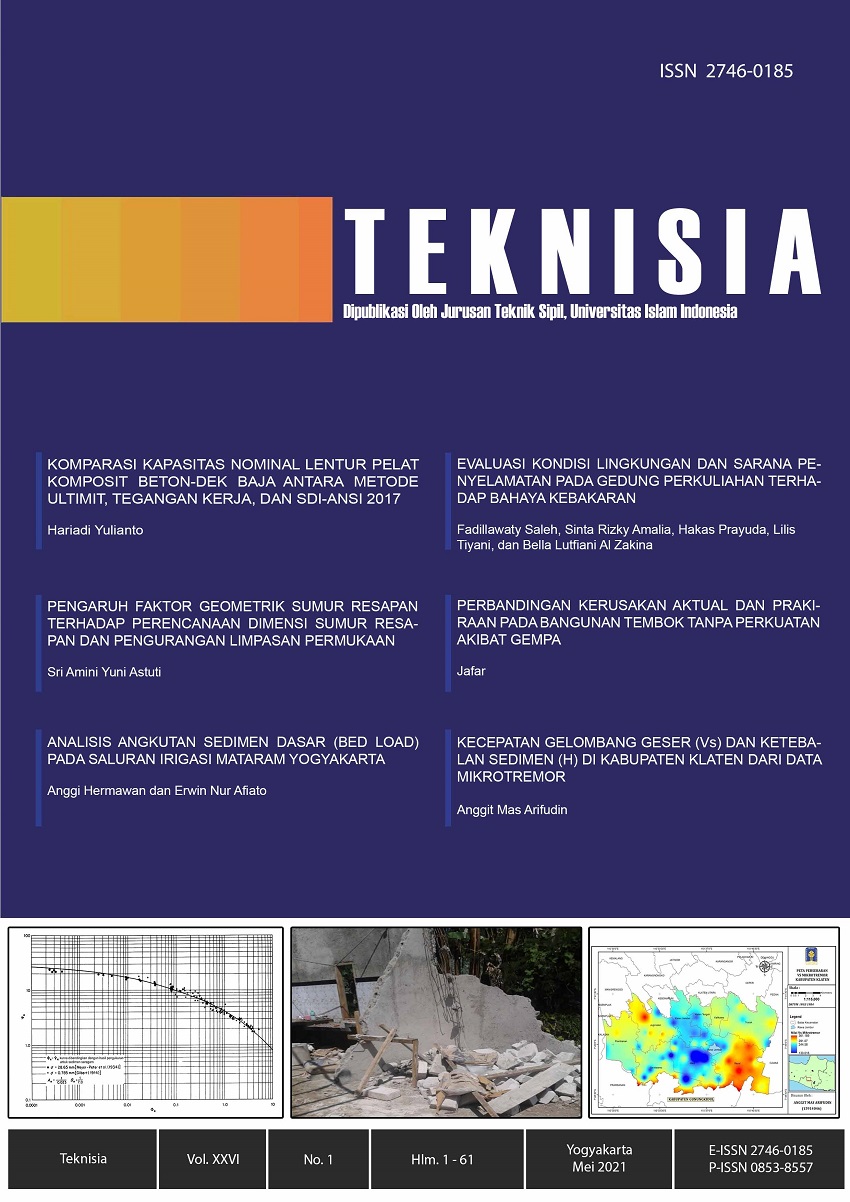Main Article Content
Abstract
To solve the problem of flooding, and to conserve groundwater, many infiltration wells have been built. To plan the dimensions and number of infiltration wells, that is influenced by the geometric factor of an infiltration well. Therefore, this paper will discuss the influence of infiltration well geometric factor on the dimensional planning and the number of infiltration wells needed, as well as those that are feasible to build based on existing land limitations. The planning of infiltration wells uses the Sunjoto method. The study location is on the UII integrated campus. Rainfall data were taken from Prumpung station in 1998 - 2016. The larger the infiltration well geometric factor, the smaller the number and dimensions of infiltration wells. For example, in the D3 Ekonomi complex, for a type of infiltration well with a diameter of 1,5 m and a height of 4 m, with , 8 units are needed, while an infiltration well with requires 7 units. Likewise for other complexes. With the limited land available, the greater the infiltration well geometric factor used, the reduction in surface runoff is not much change, almost the same, namely 59,73 % with and 59,79 % with F=7,4022 m.
Keywords
Article Details
Under the following term:
-
Attribution — You must give appropriate credit, provide a link to the license, and indicate if changes were made. You may do so in any reasonable manner, but not in any way that suggests the licensor endorses you or your use.
-
ShareAlike — If you remix, transform, or build upon the material, you must distribute your contributions under the same license as the original.
- No additional restrictions — You may not apply legal terms or technological measures that legally restrict others from doing anything the license permits.
References
- Astuti, SAY. (2020). “Kinerja Sumur Resapan Kampus Terpadu UII Tahun 2007 - 2016”, Pertemuan Ilmiah HATHI XXXVII, Palembang.
- Aziz, A, dkk. (2016). “Konservasi Air Tanah Melalui Pembuatan Sumur Resapan Air Hujan Di Kelurahan Maradekaya Kota Makassar”, Journal INTEK, Vol 3 (2): 87-90
- Bahunta, L dan Waspodo, RSB. (2019). “Rancangan Sumur Resapan Air Hujan sebagai Upaya Pengurangan Limpasan di Kampung Babakan, Cibinong, Kabupaten Bogor”, Jurnal Sipil dan Lingkungan, Vol. 4, No. 1.
- Purnama, S. (2010). “Hidrologi Air Tanah”, Kanisius, Yogyakarta.
- Prasojo, R A. (2015). “Perbandingan Perancangan Sumur Resapan Air Hujan menggunakan Metode Sunjoto dan SNI 03-2453-2002 pada Bangunan Komersial di Jl. Kaliurang Km 12 Sleman Yogyakarta”, Jurnal Teknisia.
- Sunjoto. (2015). “Drainase Pro Air”, Universitas Gadjah Mada, Yogyakarta.
- Suripin. (2004). “ Sistem Drainase Perkotaan yang Berkelanjutan”, Andi Offset, Semarang.
- Triatmojo, B. (2013).“Hidrologi Terapan”, Beta Offset, Yogyakarta.
- Wigati, R dan Ichwan, R. (2014). “Teknologi Sumur Resapan Dalam Kajian Pemaparan Hidrograf Banjir Sub DAS Ciujung”, Jurnal Fondasi, Vol. 3, No. 1.
- Wijaya, TP. (2019). “Pengaruh Sumur Resapan terhadap Pengurangan Debit Limpasan Permukaan di Kawasan Kampus Terpadu UII”, Konferensi Nasional Teknik Sipil (KONTEKS) 13, Medan.
References
Astuti, SAY. (2020). “Kinerja Sumur Resapan Kampus Terpadu UII Tahun 2007 - 2016”, Pertemuan Ilmiah HATHI XXXVII, Palembang.
Aziz, A, dkk. (2016). “Konservasi Air Tanah Melalui Pembuatan Sumur Resapan Air Hujan Di Kelurahan Maradekaya Kota Makassar”, Journal INTEK, Vol 3 (2): 87-90
Bahunta, L dan Waspodo, RSB. (2019). “Rancangan Sumur Resapan Air Hujan sebagai Upaya Pengurangan Limpasan di Kampung Babakan, Cibinong, Kabupaten Bogor”, Jurnal Sipil dan Lingkungan, Vol. 4, No. 1.
Purnama, S. (2010). “Hidrologi Air Tanah”, Kanisius, Yogyakarta.
Prasojo, R A. (2015). “Perbandingan Perancangan Sumur Resapan Air Hujan menggunakan Metode Sunjoto dan SNI 03-2453-2002 pada Bangunan Komersial di Jl. Kaliurang Km 12 Sleman Yogyakarta”, Jurnal Teknisia.
Sunjoto. (2015). “Drainase Pro Air”, Universitas Gadjah Mada, Yogyakarta.
Suripin. (2004). “ Sistem Drainase Perkotaan yang Berkelanjutan”, Andi Offset, Semarang.
Triatmojo, B. (2013).“Hidrologi Terapan”, Beta Offset, Yogyakarta.
Wigati, R dan Ichwan, R. (2014). “Teknologi Sumur Resapan Dalam Kajian Pemaparan Hidrograf Banjir Sub DAS Ciujung”, Jurnal Fondasi, Vol. 3, No. 1.
Wijaya, TP. (2019). “Pengaruh Sumur Resapan terhadap Pengurangan Debit Limpasan Permukaan di Kawasan Kampus Terpadu UII”, Konferensi Nasional Teknik Sipil (KONTEKS) 13, Medan.
